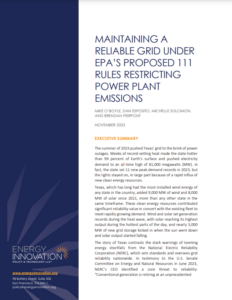The OurEnergyLibrary aggregates and indexes publicly available fact sheets, journal articles, reports, studies, and other publications on U.S. energy topics. It is updated every week to include the most recent energy resources from academia, government, industry, non-profits, think tanks, and trade associations. Suggest a resource by emailing us at info@ourenergypolicy.org.
Resource Library
Cutting steel sector emissions is essential to limiting global warming to 1.5°C by 2050, and to accomplish this goal, decarbonization and economic strategies must include ambitious action in the Great Lakes. To help state policymakers, economic development offices, and regional NGOs support the Great Lakes steel industry transition, RMI has produced a series of state-specific memos that outline:
– The scale and enabling environment required for near-zero-emissions steel production
– Gaps and opportunities for policymakers and other state-level actors to support via policy and infrastructure projects
– Specific site outlook and recommendations at the facility level…
As key consumers of steel, cement, and other major construction materials, US state governments play an influential role in reducing climate-warming emissions from manufacturing and construction projects. These emissions are commonly known as embodied carbon — the millions of tons of greenhouse gas emissions created from material extraction, manufacturing, transport, construction, and disposal. In Buy Clean and Beyond: A Guide to Reaching Net-Zero Embodied Carbon in State-Owned Building Projects, RMI provides a comprehensive framework that state agencies and policymakers can use to reach net-zero embodied carbon emissions from public building projects.…
View Full ResourceThe Environmental Protection Agency’s (EPA) proposed “111 rules” restricting greenhouse gas emissions have sparked debate about whether they will create consequences that threaten grid reliability. However, rather than raising new concerns, these objections principally raise issues already facing the power sector. The Inflation Reduction Act has made low-carbon resources including wind, solar, and storage the cheapest new resources in the U.S., but system planners worry we cannot add them fast enough to make up for fossil retirements. New Energy Innovation research details the potential impacts of the EPA rules, investigates their effects on the electricity system, and evaluates potential changes …
View Full ResourceRead this resource for a summary of Our Energy Policy’s event on Working Together for an Inclusive Energy Transformation from November 6th, 2023, discussing a just clean energy transition.…
View Full ResourceCutting steel sector emissions is essential to limiting global warming to 1.5°C by 2050, and to accomplish this goal, decarbonization and economic strategies must include ambitious action in the Great Lakes. To help state policymakers, economic development offices, and regional NGOs support the Great Lakes steel industry transition, RMI has produced a series of state-specific memos that outline:
– The scale and enabling environment required for near-zero-emissions steel production
– Gaps and opportunities for policymakers and other state-level actors to support via policy and infrastructure projects
– Specific site outlook and recommendations at the facility level…
Cutting steel sector emissions is essential to limiting global warming to 1.5°C by 2050, and to accomplish this goal, decarbonization and economic strategies must include ambitious action in the Great Lakes. To help state policymakers, economic development offices, and regional NGOs support the Great Lakes steel industry transition, RMI has produced a series of state-specific memos that outline:
1) The scale and enabling environment required for near-zero-emissions steel production
2) Gaps and opportunities for policymakers and other state-level actors to support via policy and infrastructure projects
3) Specific site outlook and recommendations at the facility level…
Utilities have conducted integrated resource planning (IRP) for decades to consider both supply- and demand-side resources to meet bulk power system needs. More recently, an increasing number of states are requiring regulated utilities to file plans that identify distribution system needs, including DERs that can avoid or defer certain types of traditional utility investments cost-effectively. Price-based demand response (DR) is an underutilized resource that could substantially contribute to load flexibility. This brief finds that evaluation of price-based DR as a solution to meet identified electricity system needs is uncommon at both planning processes. Where price-based DR is considered as a …
View Full ResourceThis report presents the results of a study on the potential grid impacts of national-scale mass deployment of geothermal heat pumps (GHPs) coupled with weatherization in single-family homes (SFHs) from 2022 to 2050. This study is an impact analysis only; installed costs and available land areas for installing GHPs are not accounted for in determining their estimated deployment. The analysis team modeled three scenarios with and without GHP deployment to a large percentage of US building floor space. In all cases, deployment of approximately 5 million GHPs per year demonstrated system cost savings on the grid, consumer fuel cost savings …
View Full ResourceEstablishing appropriate institutional architecture is important to integrate power systems across borders and facilitate electricity trading, as even if the necessary infrastructure is in place, it does not automatically follow that it is being used to exchange power effectively. The co‑ordination of all stakeholders – governments, utilities and regulators – is required within jurisdictions, as is the creation of regional entities to support and oversee the integration process.
This report therefore examines stakeholder roles at different stages of cross-border integration to enable multilateral power trade. As energy regulators are the main audience, the report focuses on their roles and responsibilities …
View Full ResourcePolicy developments in 2022 and 2023 related to the transition to renewable energy sources and associated critical minerals have yielded considerable near- and medium-term opportunities for the energy and mining sectors. But market participants will face significant headwinds in 2024 as interest rates remain elevated and economic growth slows.
Amid the complex business environment and an uncertain economic outlook, identify the key factors affecting renewable energy transition and battery supply chain in 2024.…
View Full Resource








